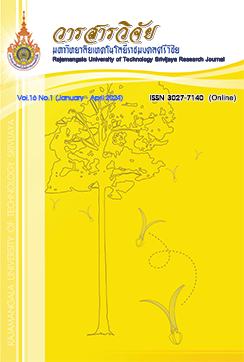Design of Bamboo Wardrobe Furniture Products by Applying Kansei Engineering Technique
Keywords:
product design, wardrobe, kansei engineering, bambooAbstract
This research aims to design bamboo wardrobe furniture products by applying Kansei engineering techniques and to create an idea for designing wardrobe products that can respond the behavior and needs of consumers. Initially, the survey data were analyzed by using quantification theory type l (multiple linear regression) in the form of a forecast equation for expressing the relationship between Kansei words and product characteristics to make a new product model. This study revealed the bamboo wardrobe products are designed and developed the product characteristics in the area of use, the material used to make the plates on the wardrobe, the opening style of the door, the appearance of the wardrobe, and the structure of the wardrobe in accordance with the emotions, feelings, and needs of consumers. The results of this study showed that new wardrobe products developed product characteristics in line with a sense of identity, which has the greatest impact on consumer satisfaction. The average satisfaction score is 4.50, which is good. Additionally, it was found that this research serves as a guideline for helping designers to design new products that can better respond to consumer behavior and needs.
References
Adiyanto, O., Jatmiko, H.A. and Erni. 2019. Development of food packaging design with kansei engineering approach. International Journal of Scientific & Technology Research 8(12): 1778-1780.
Chainun, C., Kitipattanawit, J., Saksangnand, N. and Rinsangpin, M. 2019. Development of local wisdom product bamboo furniture, in Mae Hong Son province. Rajabhat Chiang Mai Research Journal 20(2): 38-52. (in Thai)
Chen, D., Cheng, P., Simatrang, S. and Joneurairatana, E. 2021. Kansei engineering as a tool for the design of traditional pattern. AUTEX Research Journal 21(1):125-134.
Chuan, N.K., Sivajia, A., Shahiminb, M.M. and Saadb, N. 2013. Kansei engineering for e-commerce sunglasses selection in Malaysia. Procedia - Social and Behavioral Sciences 97: 707-714.
Janari, D. and Rakhmawati, A. 2016. Developing baby bag design by using kansei engineering method. Materials Science and Engineering 4(105): 12-31.
Khumpong, N. and Kasemset, C. 2012. Application of kansei engineering in food product development framework: a case study of parboiled rice, pp. 2030-2037. In Industrial Engineering Network Conference 17-19 October 2012. Cha-Am, Phetchaburi. (in Thai)
Kumsingsree, R. 2018. The relationship between bamboo hut components, Bamboo species and connectors in bamboo hut construction, Kantaravichai district, Mahasarakham province. Built Environment Inquiry Journal (BEI) 17(1): 75-96. (in Thai)
Lee, S.H., Harada, A. and Stappers, P.J. 2002. Pleasure with Products: Design based on Kansei. Copenhagen, Denmark.
Lei, Q., Zhao, Q. and Zhang, Z. 2015. Study on the materials design of furniture based on kansei engineering. International Journal of Engineering Innovation & Research 4(2): 752-756.
Phuangchik, T., Ruensuk, P. and Jirakiattikul, Y. 2015. Study on growth of four bamboo varieties. Thai Journal of Science and Technology 4(3): 302-309. (in Thai)
Pimapansri, K. 2011. New product development with kansei engineering, pp.331-337. In At the 2nd national industrial operations development symposium. The Twin Towers Hotel Bangkok, Bangkok. (in Thai)
Pinterest. 2021. Bamboo Wardrobe Furniture Products. Available Source: https://www. Pinterest.com/search/pins/?q=Bamboo %20Wardrobe%20Furniture%20Products&rs=typed, March 15, 2021.
Quan, H., Li, S. and Hu, J. 2018. Product innovation design based on deep learning and kansei engineering. Applied Sciences 8(12): 1-17.
Rahayu, M., Ekananda H.A. and Mufidah, I. 2020. Designing a reading chair using kansei engineering approach. IOP Conference Series: Materials Science and Engineering 847: 012046.
Rawangwong, S., Homkhiew, C., Phanthasri, P., Chumsri, P. 2021. Design and development of krajood decorations products using kansei engineering technique and kano’s model. UBU Engineering Journal 14(4): 181-193. (in Thai)
Roy, R., Goatman, M. and Khangura, K. 2009. User centric design and kansei engineering. CIRP Journal of Manufacturing Science and Technology 1(3): 172-178.
Shergian, A. and Immawan, T. 2015. Design of innovative alarm clock made from bamboo with kansei engineering approach. Agriculture and Agricultural Science Procedia 3:184-188.
Srisatidnarakul, B. 2012. Development and validation of research instruments: Psychometric properties. Printing House of Chulalongkorn University, Bangkok. (in Thai)
Sukjai, K., Kalsirisilp, R. and Langapin, J. 2021. Design and development of bamboo craft splitting and slicing machine. SWU Engineering Journal 16(1): 71-81. (in Thai)
Tama, I.P., Azila, W. and Hardiningtyas, D. 2015. Development of customer-oriented product design using kansei engineering and kano model: case study of ceramic souvenir. Procedia Manufacturing 4: 328-335.
Yodwangjai, S. 2014. Product design and development for dinner chair of kansei engineering. KKU Engineering Journal 41(2): 191-200. (in Thai)
Downloads
Published
How to Cite
Issue
Section
License
Copyright (c) 2024 Rajamangala University of Technology Srivijaya Research Journal

This work is licensed under a Creative Commons Attribution-NonCommercial-NoDerivatives 4.0 International License.
The content and information in the article published in Journal of Rajamangala University of Technology Srivijaya It is the opinion and responsibility of the author of the article. The editorial journals do not need to agree. Or share any responsibility.







